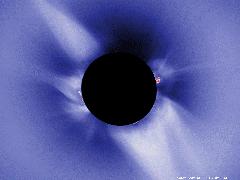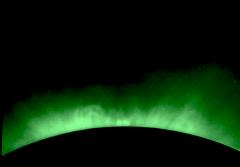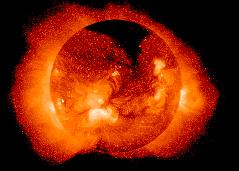Skip Navigation Links
|
The Corona
The White-Light Corona
|
 |
Click on image for larger version. |
|
The Corona is the Sun's outer atmosphere. It is visible during total
eclipses of the Sun as a pearly white crown surrounding the Sun. The corona displays a
variety of features including streamers, plumes, and loops.
These features change from eclipse to eclipse and the overall shape of the corona changes
with the sunspot cycle. However, during the few fleeting
minutes of totality few, if any, changes are seen in these coronal features.
|
The Emission Line Corona
|
 |
Click on image for larger version. |
Early observations of the visible spectrum of the corona revealed bright
emission lines at wavelengths that did not correspond to any known materials. This led
astronomers to propose the existence of "coronium" as the principal gas in the
corona. The true nature of the corona remained a mystery until it was determined that the
coronal gases are super-heated to temperatures greater than 1,000,000°C (1,800,000°F).
At these high temperatures both hydrogen and helium (the two dominant elements) are
completely stripped of their electrons. Even minor elements like carbon, nitrogen, and
oxygen are stripped down to bare nuclei. Only the heavier trace elements like iron and
calcium are able to retain a few of their electrons in this intense heat. It is emission
from these highly ionized elements that produces the spectral emission lines that were so
mysterious to early astronomers. We can now produce artificial eclipses in coronagraphs
that cover the disk of the Sun and filter out everything except the emission due to these
coronal ions. These coronagraphs produce images of the "emission line corona
|
The X-Ray Corona
|
 |
Click on image for larger version. |
|
The corona shines brightly in x-rays because of its high temperature. On
the other hand, the "cool" solar photosphere emits very few x-rays. This allows
us to view the corona across the disk of the Sun when we observe the Sun in X-rays. To do
this we must first design optics that can image x-rays and then we must get above the
Earth's atmosphere. In the early 70's Skylab carried an x-ray
telescope that revealed coronal holes and coronal bright points for the first time.
During the last decade Yohkoh, provided a wealth of
information and images on the sun's corona. Today
we have the SOHO
and TRACE satellites obtaining new and exciting
observations of the Sun's corona, its features,
and its dynamic character.
|
|




